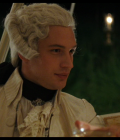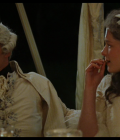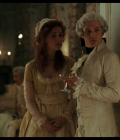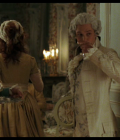Tagline: Rumor. Scandal. Fame. Revolution
Director: Sofia Coppola
Writer: Sofia Coppola
Release Date: (UK)
MPAA Rating: Rated PG-13 for sexual content, partial nudity and innuendo
Genre: Biography | Drama | History
Runtime: 123 min
Storyline
“All eyes will be on you,” says the Austrian duchess, Maria Theresa to her youngest daughter Marie Antoinette. The film, marketed for a teen audience, is an impressionistic retelling of Marie Antoinette’s life as a young queen in the opulent and eccentric court at Versailles. The film focuses on Marie Antoinette, as she matures from a teenage bride to a young woman and eventual queen of France.
Cast Highlights
| Kirsten Dunst | … Marie Antoinette |
| Jason Schwartzman | … Louis XVI |
| Judy Davis | … Comtesse de Noailles |
| Rip Torn | … Louis XV |
| Rose Byrne | … Duchesse de Polignac |
Gallery Highlights
Trivia
- The part of Louis XV was first offered to Alain Delon. Allegedly, he met Sofia Coppola for dinner and brought the American director a huge bouquet of flowers and explained he did not think this was the type of role his fans would appreciate him in. Privately it has been speculated the French icon did not have confidence in the young American director to do justice to a film on this period of French history.
- The French government granted special permission for the crew to film in the Palace of Versailles.
- Even though the Hall of Mirrors at the Palace of Versailles was in restoration – until spring 2007 – Sofia Coppola was allowed to film there a ball scene for the wedding of Marie-Antoinette and Louis XVI.
- This movie was going to be produced before Lost in Translation, but while Sofia Coppola was writing the screenplay struggling with historical truth and an imposing gallery of characters, she started creating another story in order to distract herself from the difficult enterprise. This parallel project – a small Japanese story – became “Lost in Translation”, whose planetary success revamped the Marie-Antoinette production.
- Sofia Coppola refused to read the famous biography of Marie-Antoinette written by Stefan Zweig, which she judged too strict. She turned instead to the book by Antonia Fraser, which makes the queen a more human character, a young girl with no connection to reality who finds herself in the wrong place at the wrong time.
- Sofia Coppola discovered in 2000 the Marie-Antoinette biography by French historian Evelyne Lever, acquired the book rights and asked its author to accompany her on a first tour of Versailles in 2001. Coppola later turned to the queen biography written by Antonia Fraser, more popular in the United States. Lever was later asked to work as an historical consultant for the movie, writing a dossier on the queen in order to avoid mistakes and approximations.
- Sofia Coppola had Spanish footwear designer Manolo Blahnik create hundreds of specially made shoes for the film.
- Ladurée was chosen by Sofia Coppola to make all of the brightly colored pastries and cakes for the film.
- A few quotes from the film are directly taken from Marie Antoinette’s actual life and from the biography by Lady Antonia Fraser that the film is loosely based upon. Louis XV’s comment about Marie Antoinette’s bosom upon her arrival in France, Marie Antoinette’s comment on having enough diamonds when presented with the opportunity of receiving some as a gift from Madame du Barry, Marie’s comment to Madame du Barry about there being a lot of people at Versailles on the day of their infamous first exchange of words, and Marie’s comment to her husband, Louis XVI, during a gambling party, explaining that Louis told her she could throw the party but never specified for how long are all actual exchanges of words and conversations from different events in the queen’s life.
- The original script of the movie briefly mentioned the Diamond Necklace Affair, a pivotal case in Marie Antoinette’s life, but it ends up never being mentioned in the movie.
- One ancient harp built in Paris in 1783 was borrowed from the Italian “Museo dell’Arpa Victor Salvi”, in order to have a realistic environment.
- Although the film title is unhyphenated, the real life Marie-Antoinette was written with a hyphen.
- Sofia Coppola had originally wanted Angelina Jolie for the role of Madame Du Barry, but turned it down to star in The Good Shepherd, then Catherine Zeta-Jones was considered. The role eventually went to Asia Argento.
- Was ranked #3 on US Weekly’s “Top Ten Films of 2006”.
- As is shown in the movie, Marie Antoinette was not allowed to keep her pug, Mops, when she entered France. However, later on Count Mercy arranged for the pug to be sent to her after her marriage.
- Sofia Coppola based the look of Count Axel von Fersen (Jamie Dornan) on 1980s pop singer Adam Ant.
- Director Sofia Coppola, the daughter of The Godfather director Francis Ford Coppola, included in her cast many performers who are also children of famous film professionals: her cousin, Jason Schwartzman, is the son of actress Talia Shire and producer Jack Schwartzman; Asia Argento is the daughter of Italian horror director Dario Argento; Mary Nighy is the daughter of British actor Bill Nighy; Katrine Boorman is the daughter of British director John Boorman; Danny Huston is the son of American director John Huston and the grandson of character actor Walter Huston; and Io Bottoms, who played a lady-in-waiting, is the daughter of actor Sam Bottoms (brother of Ben Bottoms, Timothy Bottoms, and Joseph Bottoms) and Susan Arnold.
- According to some history accounts, when Marie Antoinette met the rioters on the balcony of the palace, she had her eldest daughter with her. This was supposedly in order to augment a sense of sympathy for the doomed queen.
- Judy Davis, who plays the Comtesse de Noailles, was initially considered for the Maria Theresa role (played by Marianne Faithfull).
- The red gown with three jeweled buttons Asia Argento (Comtesse du Barry) wears, the red satin bejeweled gauntlets Kirsten Dunst wears, and the black and pink cloak Dunst wears in the coach returning from Paris, were all worn by Hilary Swank (Jeanne St. Remy de Valois) in The Affair of the Necklace. The birdcage hat Rose Byrne (Duchesse de Polignac) wears is the same one Joely Richardson (Marie-Antoinette) wears in that film.
- Marianne Faithfull’s mother, Eva von Sacher-Masoch, Baroness Erisso, was originally from Vienna, Austria, with aristocratic roots in the Hapsburg Dynasty. In the movie, Marianne Faithfull plays Empress Maria Theresa, a member of the Hapsburg Dynasty and Empress of Austria.
- The blue and gold robe a la Francaise Shirley Henderson wears as Aunt Sophie was previously worn by Geraldine Somerville as Lady Emily in Aristocrats (during the scene of Lord Kildare having dinner at Richmond House). The same gown also appeared previously in Doctor Who on Sophia Myles in the final ballroom scene of Doctor Who: The Girl in the Fireplace.
- Joseph II is an odd choice to teach Louis XVI about reproduction. All of Joseph’s known children died in childhood, and he apparently never reproduced for the last 27 years of his life. He could, however, afford to rest on the laurels of his brother and heir-presumptive Leopold II, who had many children including Franz II (powerful rival and ally of Napoléon Bonaparte).
- When Marie-Antoinette is going through her shoes while preparing for a big party you see a pair of blue Converse All Star 1923 Chuck Taylor basketball shoes for about one and a half seconds. While these shoes were definitely not in existence at the time of Marie-Antoinette, their inclusion in the film was intentional, to portray Marie-Antoinette as a typical teenage girl despite the time she lived in.





